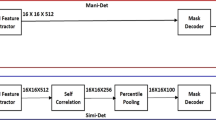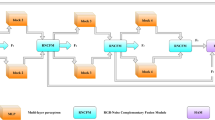Abstract
In recent years, significant progress has been made in image forgery localization technology, but there are still shortcomings in accuracy and robustness, especially for different types of forgeries. Currently, convolutional neural networks are the mainstream forgery localization technology, but the local receptive field of convolutional operations limits the accuracy of the model. In this paper, an image forgery localization neural network model is proposed, which uses the ringed residual structure to extract features better and multiple attention mechanisms to focus on important features better. The method can effectively handle various common forgeries types, such as copy-paste, region replacement, and local modification, and can also overcome the problem of the local receptive field of convolutional operations to achieve long-distance feature dependencies. The authors conducted experiments on multiple datasets to verify and compare the proposed method with existing methods. The experimental results show that the method achieved excellent performance on different datasets, demonstrating its effectiveness and robustness.
Access this chapter
Tax calculation will be finalised at checkout
Purchases are for personal use only
Similar content being viewed by others
References
Liu, B., et al.: D-UNet: a dual-encoder U-Net for image splicing forgery detection and localization. arXiv preprint arXiv:2012.01821 (2020)
Bi, X., Wei, Y., Xiao, B., et al.: RRU-Net: the ringed residual U-Net for image splicing forgery detection. In: Proceedings of the IEEE/CVF Conference on Computer Vision and Pattern Recognition Workshops (2019)
Liu, X., Liu, Y., Chen, J., et al.: PSCC-Net: progressive spatio-channel correlation network for image manipulation detection and localization. IEEE Trans. Circuits Syst. Video Technol. 32(11), 7505–7517 (2022)
Kwon, M.J., Yu, I.J., Nam, S. H., et al. Cat-net: Compression artifact tracing network for detection and localization of image splicing. In: Proceedings of the IEEE/CVF Winter Conference on Applications of Computer Vision, pp. 375–384 (2021)
Dong, J., Wang, W., Tan, T.: CASIA image tampering detection evaluation database. In: 2013 IEEE China Summit and International Conference on Signal and Information Processing. IEEE, pp. 422–426 (2013)
Hsu, Y.F., Chang, S.F.: Detecting image splicing using geometry invariants and camera characteristics consistency. In: 2006 IEEE International Conference on Multimedia and Expo, IEEE, pp. 549–552 (2006)
Salloum, R., Ren, Y., Kuo, C.C.J.: Image splicing localization using a multi-task fully convolutional network (MFCN). J. Visual Commun. Image Represent. 51, 201–209 (2018)
Long, J., Shelhamer, E., Darrell, T.: Fully convolutional networks for semantic segmentation. In: Proceedings of the IEEE Conference on Computer Vision and Pattern Recognition, pp. 3431–3440 (2015)
Liu, B., Pun, C.M.: Locating splicing forgery by fully convolutional networks and conditional random field. Signal Process.: Image Commun. 66, 103–112 (2018)
Zhang, R., Ni, J.: A dense u-net with cross-layer intersection for detection and localization of image forgery. In: ICASSP 2020–2020 IEEE International Conference on Acoustics, Speech and Signal Processing (icassp). IEEE, pp. 2982–2986 (2020)
Shi, Z., Shen, X., Kang, H., et al.: Image manipulation detection and localization based on the dual-domain convolutional neural networks. IEEE Access 6, 76437–76453 (2018)
He, K., Zhang, X., Ren, S., et al.: Deep residual learning for image recognition. In: Proceedings of the IEEE Conference on Computer Vision and Pattern Recognition, pp. 770–778 (2016)
Zhang, Z., Liu, Q., Wang, Y.: Road extraction by deep residual u-net. IEEE Geosci. Remote Sens. Lett. 15(5), 749–753 (2018)
Ronneberger, O., Fischer, P., Brox, T.: U-Net: convolutional networks for biomedical image segmentation. In: Navab, N., Hornegger, J., Wells, W.M., Frangi, A.F. (eds.) MICCAI 2015. LNCS, vol. 9351, pp. 234–241. Springer, Cham (2015). https://doi.org/10.1007/978-3-319-24574-4_28
Oktay, O., Schlemper, J., Folgoc, L.L., et al.: Attention u-net: Learning where to look for the pancreas[J]. arXiv preprint arXiv:1804.03999 (2018)
Hu, J., Shen, L., Sun, G.: Squeeze-and-excitation networks. In: Proceedings of the IEEE Conference on Computer Vision and Pattern Recognition, pp. 7132–7141 (2018)
Hou, Q., Zhou, D., Feng, J.: Coordinate attention for efficient mobile network design. In: Proceedings of the IEEE/CVF Conference on Computer Vision and Pattern Recognition, pp. 13713–13722 (2021)
Wei, Y., Ma, J., Wang, Z., et al.: Image splicing forgery detection by combining synthetic adversarial networks and hybrid dense U-net based on multiple spaces. Int. J. Intell. Syst. 37(11), 8291–8308 (2022)
Author information
Authors and Affiliations
Corresponding author
Editor information
Editors and Affiliations
Rights and permissions
Copyright information
© 2023 The Author(s), under exclusive license to Springer Nature Switzerland AG
About this paper
Cite this paper
Guo, Y., Jiang, S. (2023). A Neural Network Model with the Ringed Residual Block and Attention Mechanism for Image Forgery Localization. In: Lu, H., et al. Image and Graphics . ICIG 2023. Lecture Notes in Computer Science, vol 14358. Springer, Cham. https://doi.org/10.1007/978-3-031-46314-3_8
Download citation
DOI: https://doi.org/10.1007/978-3-031-46314-3_8
Published:
Publisher Name: Springer, Cham
Print ISBN: 978-3-031-46313-6
Online ISBN: 978-3-031-46314-3
eBook Packages: Computer ScienceComputer Science (R0)




